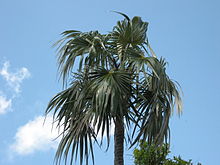Coccothrinax argentata
| Coccothrinax argentata | |
|---|---|
 |
|
| Coccothrinax argentata, Bahia Honda Key, Monroe County, Florida | |
| Scientific classification | |
| Kingdom: | Plantae |
| (unranked): | Angiosperms |
| (unranked): | Monocots |
| (unranked): | Commelinids |
| Order: | Arecales |
| Family: | Arecaceae |
| Genus: | Coccothrinax |
| Species: | C. argentata |
| Binomial name | |
|
Coccothrinax argentata (Jacq.) L.H.Bailey |
|
Coccothrinax argentata, commonly called the Florida silver palm, is a species of palm tree. It is native to the West Indies, where it is found in the Bahamas, south Florida, southeast Mexico, and San Andrés Island. Its natural habitat is rocky, calcareous soil where it is found in coastal scrub and hammock communities.
It is a small (2–6 m tall), slow-growing fan palm with leaves that are dark blue-green above and silver-coloured below. Measurements in Fairchild Tropical Garden showed an average growth rate of 12 centimetres (4.7 in) per year. Flowers are white and small on light orange branches. The fruits are globose and half an inch in diameter. They are initially green and turn purple or black when ripe.
Silver Palms in their natural habitat often grow among saw palmetto (Serenoa repens) and cabbage palmetto (Sabal palmetto) which have similar fronds. Silver Palms can be distinguished by its smooth vertical trunk, and its small, crescent-shaped hastula.
The endangered Florida Key Deer are known to feed on the fruits of the silver palm.
Bahia Honda State Park in the Florida Keys has one of the largest stands of silver palms in the United States. They can be found on a nature walk just off of Sandspur Beach.
...
Wikipedia

